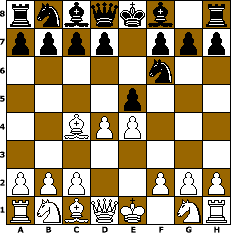The Bishop´s Opening is a chess opening that begins with the moves
1.e4 e5 2.Bc4
The Bishop´s Opening is one of the oldest openings to be analyzed; it was studied by Lucena and Ruy Lopez. Later it was played by Philidor. Larsen was one of the few grandmasters to play it often, after first using it at the 1964 Interzonal Tournament. Although the Bishop´s Opening is uncommon today, it has been used occasionally as a surprise by players such as Kasparov and Nunn.
White attacks Black´s f7-square and prevents Black from advancing his d-pawn to d5.
By ignoring the beginner´s rule, "develop knights before bishops", White leaves his f-pawn unblocked allowing the possibility of playing f4. This gives the Bishop´s Opening an affinity to the King´s Gambit and the Vienna Game, two openings that share this characteristic. In fact, the Bishop´s Opening can transpose into the King´s Gambit or the Vienna Game, and transpositions into Giuoco Piano and Two Knights Defense and other openings are also possible. In particular, White should remain alert for any chance to transpose into a favorable variation of the King´s Gambit, but with careful play Black can avoid this danger.
Main variations
Because White´s second move makes no direct threats, Black has many possible responses on the second move.
As shown below, the Bishop´s Opening offers opportunities to transpose to several other open games.
After 1.e4 e5 2.Bc4, Black´s choice of a second move can be divided into three categories.
Berlin Defense (2...Nf6)
 |  |  | | 3.d3 | 3.d4 (Ponziani´s Gambit) | 3.f4 (Greco Gambit) |
Probably Black´s most popular second move is 2...Nf6, forcing White to decide how to defend her e-pawn. After 3.d3 Black must be careful not to drift into an inferior variation of the King´s Gambit Declined.
One possible continuatation that avoids this pitfall is 2...Nf6 3.d3 c6 4.Nf3 d5 5.Bb3 Bd6.
White sometimes chooses the Bishop´s Opening move order to transpose into the Giuoco Piano while preventing Black from playing the Petrov Defense. For example, 2...Nf6 3.d3 Nc6 4.Nf3.
The Urusov Gambit is named after Russian Prince Sergey Semyonovich Urusov (born August 3, 1827, died November 20, 1897).
Black can decline the Urusov Gambit and transpose into the Two Knights Defense with 2...Nf6 3.d4 exd4 4.Nf3 Nc6.
If Black accepts the gambit, White gets some initiative, 4...Nxe4 5.Qxd4 Nf6 6.Nc3 Be7 7.Bg5.
The Boden-Kieseritzky Gambit was suggested by Kieseritzky in 1848, and English player and chess writer Samuel Standidge Boden (1826–1882) published the first analysis of the gambit in 1851.
It is perhaps unsound, since after 2...Nf6 3.Nf3 Nxe4 4.Nc3 Nxc3 5.dxc3 f6 White´s attack may not be worth a pawn.
Black can also avoid White´s prolonged offensive in this line by returning the pawn and transposing into the Two Knights Defense with 4...Nc6.
Classical Defense (2...Bc5)
 |  |  | | 3.b4 (Wing Gambit) | 3.c3 (Philidor Variation) | 3.d3 |
The Classical Defense is Black´s symmetrical response, 2...Bc5.
White can then transpose into the Vienna Game (3.Nc3) or the Giuoco Piano (3.Nf3), or remain in the Bishop´s Opening with the Wing Gambit (3.b4) or the Philidor Variation (3.c3).
Transpositions into the King´s Gambit Declined and the Giuoco Piano are also possible after 3.d3.
The Wing Gambit results in positions similar to those in the Evans Gambit.
It can transpose into the Evans Gambit, for instance by 2...Bc5 3.b4 Bxb4 4.c3 Ba5 5.Nf3 Nc6.
Black´s most energetic response to the Philidor Variation is the Lewis Countergambit, 2...Bc5 3.c3 d5, named for the English player and author William Lewis (1787–1870), who published analysis of the line in 1834.
Other Black second moves
Other Black second moves are rarely played.
If Black tries to transpose into the Hungarian Defense with 2...Be7?!, then 3.Qh5 wins a pawn.
The Calabrian Countergambit (2...f5?!) is named after Greco´s homeland.
It is considered dubious as the line recommended by Jaenisch, 3.d3 Nf6 4.f4 d6 5.Nf3, gives White the advantage.
References
- Hooper, David and Kenneth Whyld (1996). The Oxford Companion To Chess. Oxford University. ISBN 0-19-280049-3.
|
